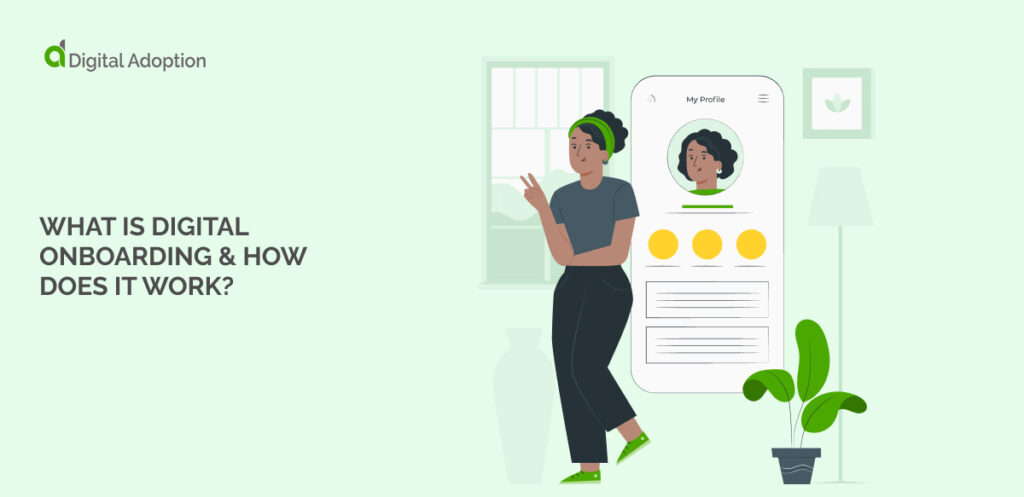We live in a digital age, and every business is looking for ways to streamline processes and provide better customer experiences.
digital onboarding is just one of the evergreen business processes to get a digital makeover. With digital technologies, you could create an efficient online process that welcomes customers into your business and helps them get up and running quickly.
In this article, we will answer all your questions about digital onboarding.
- What is digital onboarding?
- How does digital onboarding work?
- Why is digital onboarding important?
By the time you’re done reading, you’ll know everything you need to know about digital onboarding. We’ll leave you with practical steps to create a digital transformation initiative to rehaul your onboarding process.
What Is Digital Onboarding?
Digital onboarding is helping customers get up and running on your product or service using digital tools.
It’s a streamlined, automated approach that typically involves gathering customer data and preferences, setting up accounts, sending welcome emails, providing training materials and resources, and more.
The end goal of digital onboarding is to provide a pleasant customer experience, boost engagement and adoption, and ultimately increase retention.
Digital Onboarding Technologies
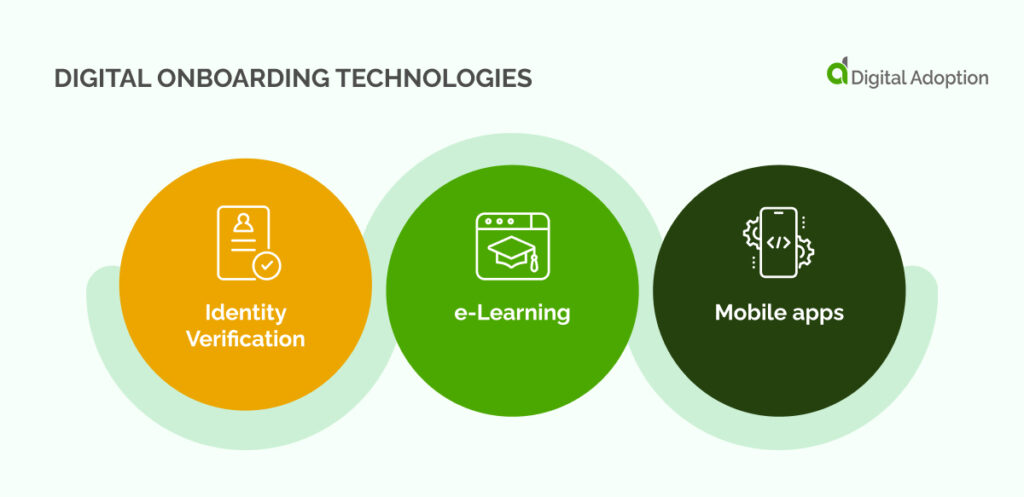
Digital onboarding is a process that relies on a number of different digital technologies.
The technologies used will change depending on your onboarding requirements, but here are a few commonly used digital onboarding technologies to help you build a better mental picture of the digital onboarding process:
Identity Verification
This is verifying customer identity to ensure that only legitimate customers gain access to your product or service.
Identity verification can be done through phone verification, email confirmation, online account security validation, and more.
e-Learning
This is using digital tools such as interactive guides, tutorial videos and webinars to help customers understand your product or service better.
e-Learning helps to reduce customer queries and enables them to get up to speed quickly while onboarding.
Mobile apps
When it comes to mobile onboarding, you can create a mobile app specifically tailored to your customers’ needs.
This can be used to provide interactive guidance and support and track progress through the onboarding process.
Mobile apps are an effective way to engage customers and ensure their successful transition into your product or service.
Digital Onboarding vs. Traditional Onboarding
Let’s take a moment to talk about traditional onboarding processes. Doing so will give you insight into the challenges that came with the rise of digital onboarding and the benefits.
On-Site Client Onboarding
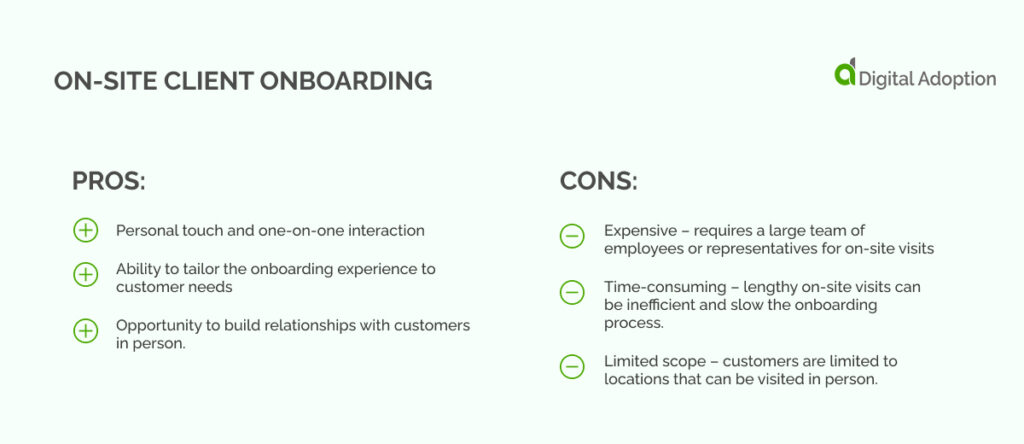
Traditional on-site client onboarding involves a personal visit from an employee or representative of your business to the customer’s premises.
The representative would typically gather data, assess needs, provide training and resources, and more in order to help customers get started with the product or service.
Pros:
- Personal touch and one-on-one interaction
- Ability to tailor the onboarding experience to customer needs
- Opportunity to build relationships with customers in person.
Cons:
- Expensive – requires a large team of employees or representatives for on-site visits
- Time-consuming – lengthy on-site visits can be inefficient and slow the onboarding process.
- Limited scope – customers are limited to locations that can be visited in person.
Hybrid Onboarding
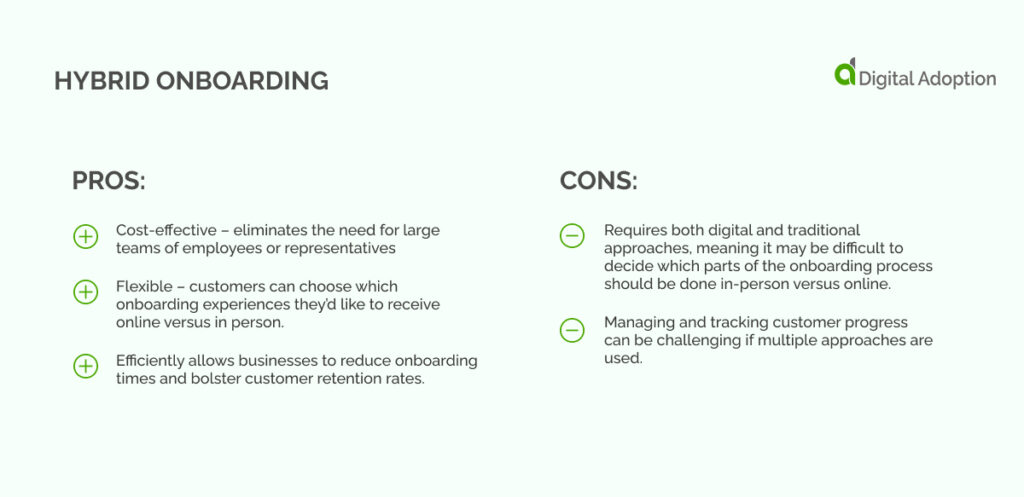
Hybrid onboarding is a blend of both digital and traditional on-site onboarding techniques.
It combines online tools and resources, such as digital tutorials and webinars, with one-on-one support from an employee or representative.
This allows customers to choose which parts of their onboarding experience they’d like to receive online versus in person.
Pros:
- Cost-effective – eliminates the need for large teams of employees or representatives
- Flexible – customers can choose which onboarding experiences they’d like to receive online versus in person.
- Efficiently allows businesses to reduce onboarding times and bolster customer retention rates.
Cons:
- Requires both digital and traditional approaches, meaning it may be difficult to decide which parts of the onboarding process should be done in-person versus online.
- Managing and tracking customer progress can be challenging if multiple approaches are used.
Overall, digital onboarding offers businesses a number of advantages that traditional on-site onboarding cannot match. Let’s talk about why.
Why Is Digital Onboarding Important?
Digital onboarding can help improve customer experience and satisfaction, reduce churn rates, and increase customer retention.
It also helps simplify the onboarding process for customers, allowing them to get up and running quickly with minimal effort.
A 2022 survey by Mckinsey found that ‘Know-your-customer due diligence’ and ‘account opening’ processes take up nearly half of the onboarding time for banks. However, 60% of banks are already offering or looking to offer instant account opening through digital KYC solutions.
This goes to show that outdated onboarding processes are a recognized problem, and it’s one that your competitors may already be addressing.
Customer onboarding is an essential step in any business relationship, so it’s important to ensure the process is as smooth and efficient as possible if you want to keep up with the competition.
The Modern Consumer
The modern consumer is tech-savvy and values convenience. A 2022 survey of nearly 10’000 consumers by PwC states that 40% of customers would pay extra for same-day delivery.
They expect a seamless, fast, and secure digital experience whenever possible— and they know the onboarding process is supposed to be just that.
In a Business-to-Consumer (B2C) setting, a poor onboarding experience will lead potential customers to abandon your product or service before they ever give it a chance.
Creating a digital onboarding process is the minimum that modern consumers expect from your business.
Digital Onboarding Benefits
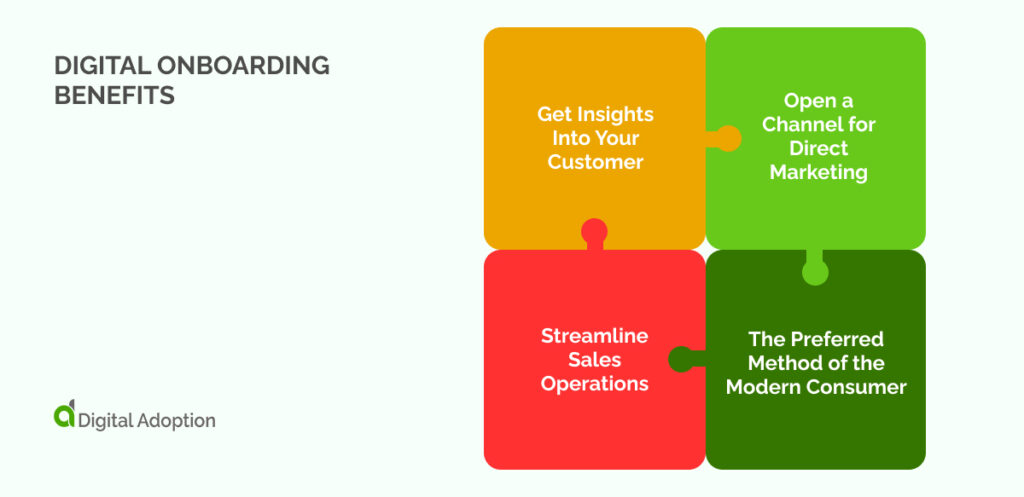
An excellent onboarding experience (of any kind) is an excellent way to build rapport with customers, which encourages loyalty and increases a customer’s lifetime value (LTV).
Furthermore, an efficient and well-designed onboarding experience minimizes your customer acquisition cost (CAC)— these two benefits, in concert, make it financially rewarding to refine your onboarding process.
However, a handful of benefits are unique to the digital onboarding process. These are:
Get Insights Into Your Customer
When you onboard customers digitally, you can collect valuable data about your customer’s needs, preferences, and behaviors.
This helps you to better understand them and personalize their experience with your brand.
Building a persona for your customer is essential to providing them with personalized recommendations— the data you can collect at the digital onboarding stage is a great headstart on creating that persona.
Open a Channel for Direct Marketing
Using the insights collected during onboarding, you can create targeted marketing campaigns to reach the right customer with the right message.
This helps ensure your campaigns are effective and allows you to further build customer trust and loyalty.
In a McKinsey survey of Medicare Advantage members, 49% said they would be interested in signing up for notifications about new benefits during the onboarding process.
It’s a win-win scenario. The modern customer wants more targeted marketing campaigns, and abiding by that expectation will reduce the cost of your marketing.
Speaking of reducing costs, there’s no more efficient way to market than to directly contact customers at virtually no cost— collecting an email address during digital onboarding is the best way to do that. Just make sure you’re handling customers’ personal data ethically.
Streamline Sales Operations
Digital onboarding eliminates manual processes such as paperwork and in-person customer visits, which are often time-consuming, costly, and inefficient.
Automating the onboarding process can streamline your sales operations and improve customer satisfaction.
The Preferred Method of the Modern Consumer
As mentioned above, and perhaps the most compelling reason of all. Modern consumers expect a seamless digital onboarding experience from businesses.
By offering customers this option, you’ll be able to attract more potential customers and retain existing ones.
Digital Onboarding Challenges
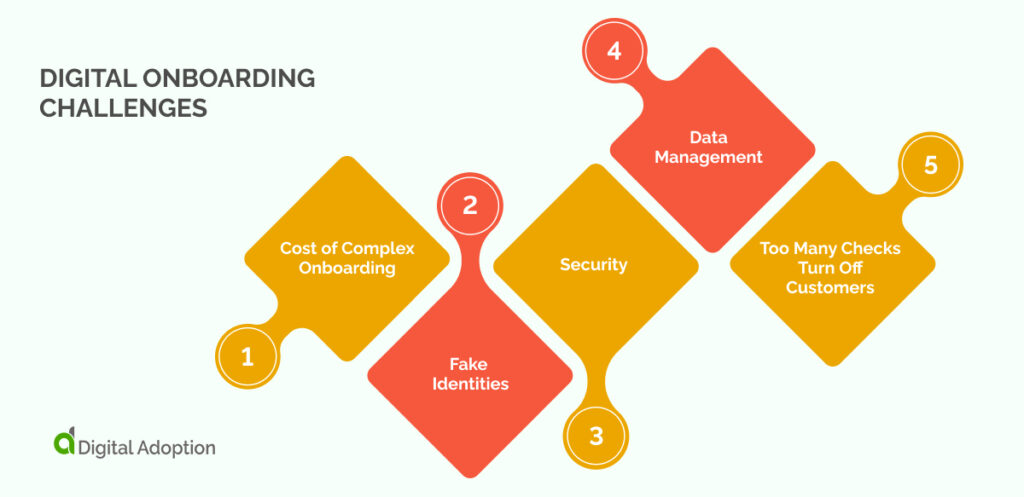
With all these benefits, it’s a wonder that any business would opt for anything other than digital onboarding, right?
In reality, digital onboarding also comes with a host of challenges that you’ll have to address.
Cost of Complex Onboarding
Creating an efficient, secure, user-friendly onboarding process requires time, money, and resources.
It’s a complex task that requires expertise in developing and designing a customer journey map with the most optimal experience for your customers.
Onboarding is more complex in some industries, like healthcare and banking.
McKinsey reports that for several steps of the onboarding process, 50% of banks use in-house solutions. This is because banks have very specific onboarding requirements. If your business faces a similar challenge, you must be prepared to develop bespoke software to address your needs.
Fake Identities
Digital onboarding is vulnerable to identity fraud, which can result in serious financial losses and damage to reputation.
Biometric checks are commonplace, but they can be beaten.
Emerging technologies like artificial intelligence (AI) deep fakes are one of the more recent challenges that identity verification technology needs to overcome.
To protect yourself, you must have strong authentication methods to verify customer identities.
Security
Data security is another challenge when it comes to digital onboarding.
To protect customer information, you need to ensure data security in transit (through encryption) and at rest (through secure cloud storage, for example).
Data Management
On top of protecting data, you need to be prepared to manage it.
You need to have systems that allow you to keep customer data up-to-date, accessible, and organized.
Data lifecycle management (DLM) is one approach you can take to help you manage customer data the right way.
Too Many Checks Turn Off Customers
There’s a fine line between a digital onboarding process that’s too simple and too complex.
The onboarding process should be simple enough for customers to complete quickly and easily. Too many checks or complex processes can turn off potential customers, leading them to abandon the onboarding process altogether.
Ensure your digital onboarding process is straightforward and easy to understand— this will help ensure customers have a positive onboarding experience.
Furthermore, offering customers the option to save their information for future use can make the process even more seamless.
Digital Onboarding Process: Best Practices
If you’re ready to take the next step and design your own digital onboarding process, you should keep a few best practices in mind.
These best practices will help you create a successful digital onboarding experience for your customers, setting you up for long-term success:
One Pane of Glass
The first best practice is to create a “one pane of glass” experience for customers.
This means providing customers with a single, integrated platform from which they can access their information and services.
This helps streamline the onboarding process and makes it easier for customers to complete any necessary tasks— such as completing forms or verifying identity.
Easy, Fast, Seamless
Your digital onboarding process should be easy, fast, and seamless.
Remember that the onboarding process should be easy-to-understand and require minimal steps to complete.
Providing customers the ability to save their information is also key, as this will help make future customer onboarding smoother and faster.
You should also be transparent about timing. It’s fine to have a long onboarding process as long as your customers are prepared for it. Presenting a checklist at the beginning of the onboarding process is a popular way to achieve this.
Tech-enabled, Data-powered
Digital onboarding should be tech-enabled and data-powered.
The latest technology, such as AI or DLM, will help you streamline onboarding processes and maximize customer engagement.
This ensures a positive customer experience and helps protect your business from fraudsters.
Anywhere, Any time
Finally, your digital onboarding process should be accessible from anywhere, anytime.
An online platform enables customers to complete onboarding processes anytime, from any device.
This helps ensure that customers can access services quickly and easily— no matter where they are or the time.
Optimize your Customer Onboarding Process Today
You only get one shot at a first impression.
Optimizing for a great digital onboarding experience is how you make the most of that one shot.
You see, the onboarding process is a little like herding sheep; if there’s a single open gate along the path, your potential customers will leak through it.
There are many reasons to develop a robust, customer-centric digital onboarding process— and at the forefront of them is that it’s a set-it-and-forget-it solution that drives business growth even when you’re offline.

